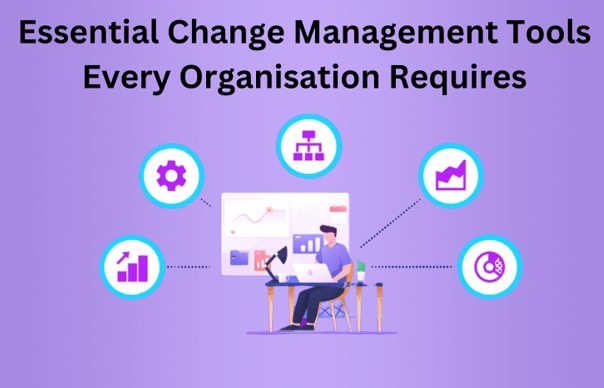Change is never-ending in every organisation whether it involves putting new technology to use, reorganising procedures, or responding to changes in the market. Organisational success, however, depends on how well change management is done. Change Management Tools are essential to enabling seamless transfers, reducing interruptions, and guaranteeing the accomplishment of the intended results. Change Management Certification is a great way to understand the intricacies of these tools.
This blog will look at the fundamental change management tools any company needs to negotiate times of transition successfully.
Table of Contents
- Communication Tools
- Project Management Tools
- Training and Development Tools
- Feedback and Survey Tools
- Change Impact Assessment Tools
- Conclusion
Communication Tools
Change management that’s successful begins with effective communication. For information sharing, expectation communication, and problem resolution, organisations need robust communication tools. Let’s see these resources below:
- Email: An all-around tool for informing stakeholders of updates, announcements, and project progress reports
- Intranet: Central location where staff members may obtain pertinent policies, documents, and leadership communication.
- Collaboration Software: Platforms enabling real-time team communication, collaboration, and task management such as Slack, Microsoft Teams, and Asana.
- Town Hall Meetings: Large-scale events at which the leadership presents the goals, justifications, and status of change projects while also offering chance for employee input and queries.
Project Management Tools
Change initiatives are often intricate projects with several responsibilities, due dates, and stakeholders. Tools for project management support the planning, arranging, and monitoring of change projects. Among widely used project management tools are:
- Trello: A visual project management application that tracks progress and organises tasks using boards, lists, and cards.
- Jira: Particularly helpful for software development projects, Jira lets teams schedule, monitor, and publish software revisions.
- Microsoft Project: A complete project management tool that tracks budgets, distributes resources, and schedules.
- Gantt Charts: Project timelines, dependencies, and milestones are commonly represented graphically with Microsoft Excel or specialised applications like Smartsheet.
Training and Development Tools
Change often calls for staff members to learn new abilities, adopt new procedures, or comprehend new technology. Tools for training and development are crucial to provide staff members with the skills and information required to thrive in the constantly evolving workplace. Among these resources might be:
- Learning Management Systems (LMS): Centralised archives of training materials, courses, and exams are offered by sites like Moodle, Canvas, or Cornerstone.
- Webinars and Online Courses: Subject matter experts lead interactive online courses and webinars to teach staff members about change initiative-related subjects.
- Simulations and Virtual Labs: Practical learning opportunities allow staff members to hone new abilities or procedures in a regulated, secure setting before use.
- Job Aids and Manuals: Reference documents, user manuals, and job aids that offer detailed directions and troubleshooting advice for carrying out change-related tasks.
Feedback and Survey Tools
Assessing the effect of change, bringing up development opportunities, and keeping stakeholders involved during the change process all depend on getting their input. Analysis, and action of feedback is made possible for organisations by feedback and survey technologies. These tools include:
- SurveyMonkey: Online survey platform SurveyMonkey enables businesses to design, share, gather, and evaluate survey data.
- Pulse Surveys: Brief, regular polls intended to assess employee mood, quantify levels of involvement, and monitor changes over time.
- Focus Groups: Moderated informal discussions used to investigate subjects, get information, and develop suggestions for improvement.
- 360-Degree Feedback Tools: Systems that assemble input from several sources (e.g., managers, direct reports) to clearly depict a person’s performance or effectiveness as a leader.
Change Impact Assessment Tools
Planning and reducing the risks associated with a shift depends on understanding the possible effects of change. Tools for assessing change effect enable organisations to examine how changes affect people, processes, and systems. Among these resources are:
- Stakeholder Analysis Templates: Structures for determining important stakeholders, evaluating their degree of interest and influence, and creating customised engagement and communication plans.
- Risk Assessment Matrices: These are the tools for identifying and ranking risks related to the project of change regarding their probability and possible results.
- SWOT Analysis: A strategic planning tool that the organisation can use to find the change project’s strengths, weaknesses, opportunities and threats.
- Change Readiness Surveys: Surveys designed to determine the extent of staff members’ readiness for change reveal possible difficulties and areas where more support is needed.
Conclusion
In the ever-changing corporate world of today, organisations must manage change. Organisations may successfully negotiate times of change, reduce opposition, and increase the possibility of good results using the appropriate tools and strategies. Every tool—from training and feedback systems to project management and communication tools—is essential to enabling seamless transitions and developing a resilient and flexible culture inside the company. Purchasing robust change management solutions will continue to be strategically necessary to promote innovation, expansion, and competitive advantage as businesses develop and change. For more information visit the website: The Knowledge Academy













